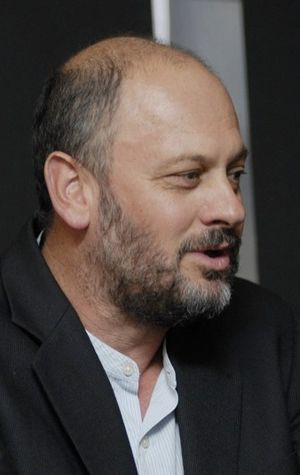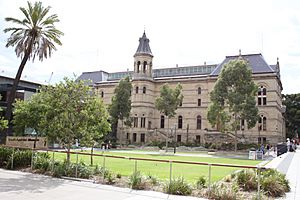Tim Flannery facts for kids
Quick facts for kids
Tim Flannery
|
|
|---|---|

Tim Flannery at the 5th World Conference of Science Journalists, 2007
|
|
| Born |
Timothy Fridtjof Flannery
28 January 1956 |
| Alma mater | La Trobe University, Monash University, University of New South Wales |
| Occupation |
|
| Organisation | Climate Council University of Melbourne Graduate Institute of International and Development Studies |
| Known for | Writing and speaking about climate change |
|
Notable work
|
|
| Spouse(s) | Paula Kendall, Alexandra Szalay |
| Children | 3 |
| Awards | Australian of the Year (2007) Full list |
Timothy Fridtjof Flannery (born 28 January 1956) is an Australian scientist, author, and environmentalist. He is known for his work on ancient animals and for talking about climate change.
He wrote The Future Eaters in 1994, which was about the natural history of Australia and nearby islands. This book was later made into a TV show. In 2006, he wrote The Weather Makers, which explained the effects of climate change.
As a researcher, Flannery worked at several universities and museums in Australia. He studied fossil marsupials and how mammals evolved. He found many new species and helped us understand the ancient animals of Australia and New Guinea. He also surveyed mammals in Melanesia, finding 17 new species.
He has written many books about nature and the environment. He also appears on TV and in the media. In 2007, he was named Australian of the Year for his important work on environmental issues.
Flannery became well-known for sharing information about climate change. In 2011, he led the Climate Commission, a group that gave information about climate change to Australians. When this group was closed in 2013, Flannery and other scientists started the Climate Council. This new group still shares independent climate science with the public. Flannery supports actions to slow down climate change, like using renewable energy and stopping the use of coal power.
Contents
Early Life and Learning
Timothy Fridtjof Flannery was born on 28 January 1956 in Melbourne, Australia. He grew up near the bay and spent his time looking for fossils. He also learned to fish and scuba dive. He noticed how marine pollution affected living things even when he was young.
He first studied English literature at La Trobe University. Later, he became interested in zoology and paleontology. He earned a Master of Science degree from Monash University in 1981. In 1984, he completed his PhD at the University of New South Wales. His PhD research was about the evolution and fossils of kangaroos and their relatives.
Science Career
In 1984, Flannery became the head of the Mammalogy Department at the Australian Museum. He traveled to Papua New Guinea and the Solomon Islands many times. He worked closely with local tribes to study animals in their natural homes. He wrote about these trips in his book Throwim Way Leg.
From 1999 to 2006, he was a professor at the University of Adelaide. During this time, he also directed the South Australian Museum in Adelaide.

In 2007, Flannery became a professor at Macquarie University. He focused on the risks of climate change. He has written more than 143 scientific papers. As of November 2024, Flannery is a professor at the University of Melbourne.
Discoveries and Contributions
Ancient Animals
In 1980, Flannery found an Allosaurid dinosaur fossil in Victoria, Australia. This was the first time such a fossil was found in Australia. In 1985, he helped discover Steropodon, a very old fossil of a monotreme (like a platypus). This discovery showed that Australian mammals have a history going back 80 million years.
He also described many large ancient animals from New Guinea. He studied the evolution of phalangerids (a family of possums). For his PhD, he described 29 new fossil species of kangaroos and their relatives.
Mammal Discoveries

In the 1990s, Flannery explored the mammals of Melanesia. He found more than 30 species and helped protect animals in the region. He identified at least 17 species that scientists had not known about before. These included the Dingiso and several tree kangaroos. He also found living Bulmer's fruit bats, which were thought to be extinct.
His work led Sir David Attenborough to call him one of the "all-time great explorers."
Talking About Climate Change
In the 1990s, Flannery noticed changes in trees in New Guinea. He realized this was likely due to climate change. From the 2000s, he started focusing on telling people about climate change.
Flannery has often talked about the effects of climate change, especially in Australia. He encourages people to take action to slow it down. During the huge Black Summer bushfires in 2019–20, he explained how climate change was connected to these fires. He said he was "absolutely certain" the fires were caused by climate change.
Climate Commission
In 2011, Flannery was chosen to lead the Climate Commission. This group was set up by the Australian government to explain climate change to the public. It aimed to provide reliable information for everyone.
In 2013, a new government closed the Climate Commission. Flannery was told his position was ended. He said the government also took down the commission's website, which had useful information for teachers and others.
Climate Council
After the Climate Commission was closed, Flannery and other scientists quickly started a new group. They called it the Climate Council. This new group had the same goal: to give independent information about climate change science.
The Climate Council raised a lot of money from public donations. This allowed them to continue their important work. The Climate Council still operates today, supported by donations from people who care about climate change.
TV and Movies
Flannery has appeared in several TV shows for ABC Television. He often worked with comedian John Doyle on travel documentaries. These included Two Men In A Tinnie, where they traveled down the Murray River. They also made Two in the Top End in the Kimberley.
In 2017, Flannery hosted an episode of ABC Catalyst. He explored how growing seaweed could help fight climate change by taking carbon from the air. He also appeared in the 2021 documentary film Burning, which was about the Black Summer bushfires.
His Ideas and Support
Flannery's work in raising awareness about environmental issues helped him become Australian of the Year in 2007.
Climate Change Views
Flannery has long spoken about the impacts of climate change in Australia and worldwide. In 2004, he warned about water shortages in cities like Perth and Sydney. He said that even with rain, dams might not fill because of increased soil evaporation.
In 2019, Flannery said that people should be angry about the climate crisis. He noted that the problems scientists warned about 20 years ago were now happening. He praised young climate activists like Greta Thunberg and groups like Extinction Rebellion for their impact.
Energy Views
Flannery supports Australia moving to renewable energy. He believes that traditional coal-fired power plants should be phased out. He compares burning coal to asbestos, saying it will lose public acceptance.
He once supported nuclear power as a way to reduce carbon emissions. However, he changed his mind in 2007. He now believes Australia has enough renewable resources that it doesn't need nuclear power. He thinks Australia should supply its uranium to other countries that do need it.
Geothermal Energy
In 2005, Flannery suggested that hot rocks in South Australia could provide enough energy to power Australia for a century. He even imagined a "sustainable city" called "Geothermia" that would use this geothermal energy. An exploration company was set up, but the project closed in 2016 because it was not financially possible.
Animal Introductions

In his book The Future Eaters, Flannery criticized how European settlers brought non-native animals to Australia. However, he also suggested that to bring back ancient ecosystems, some non-native species could be introduced carefully. For example, he thought the Komodo dragon could replace the extinct Megalania, a giant lizard. He also suggested the Tasmanian devil could return to mainland Australia.
In another book, The Eternal Frontier, Flannery proposed "Pleistocene rewilding" for North America. This idea is about bringing back ecosystems that existed before humans arrived. He suggested introducing animals like jaguars and lions to control elk numbers. He also thought that Indian and African elephants could act as substitutes for extinct mammoths and mastodons.
Awards and Recognition
- 1990: Edgeworth David Medal for excellent research in zoology
- 1996: POL Eureka Prize for Environmental Research
- 2003: Centenary of Federation Medal for his services to Australian science
- 2005: Australian Humanist of the Year
- 2006: Lannan Literary Award for Non-Fiction for The Weather Makers
- 2007: Australian of the Year
- 2012: Fellow, Australian Academy of Science
- 2015: Jack P. Blaney Award for Dialogue, for sharing knowledge about climate change
- 2018: Fellow, Royal Zoological Society of New South Wales
Other Activities
Flannery has also written fiction, though it has not been published. He has served on the editorial board of the Journal of Zoology. He was also a board member for the New South Wales National Parks Service Foundation.
He has been involved with groups like the National Environmental Education Council and the National Geographic Society. As of 2015, he was a member of the Wentworth Group of Concerned Scientists and a governor of WWF-Australia.
Personal Life
Flannery describes himself as a humanist. He has two children with his first wife, Paula Kendall. Their home was destroyed in a bushfire in 1994. He later married anthropologist Alexandra Szalay. He has a third child with his partner Kate Holden.
He used to live in a house only reachable by boat, north of Sydney. This house had a solar hot water system.
Filmography
Television
- The Future Eaters (1998)
- Two Men in a Tinnie (2006)
- Two in the Top End (2008)
- Two on the Great Divide (2012)
- Coast Australia (2013–2017)
- Two Men in China (2014)
- Australia: The Story of Us (2015)
Film
- Kangaroo: A Love-Hate Story (2017)
- Burning (2021)


